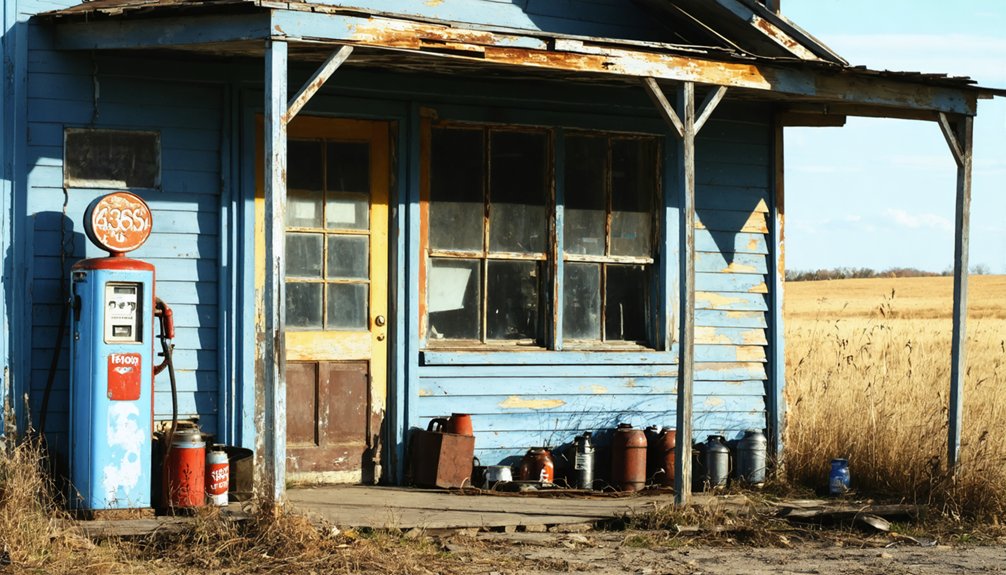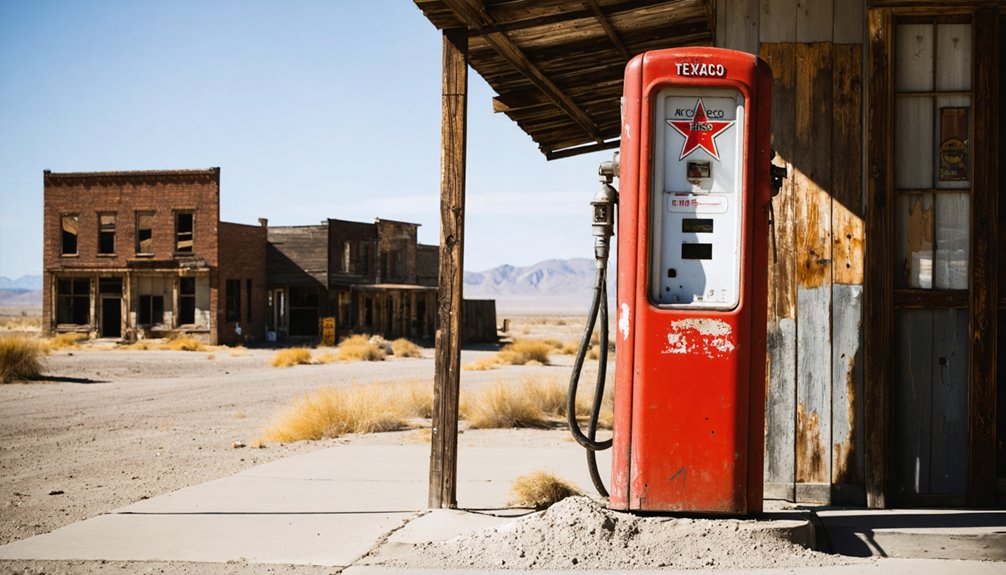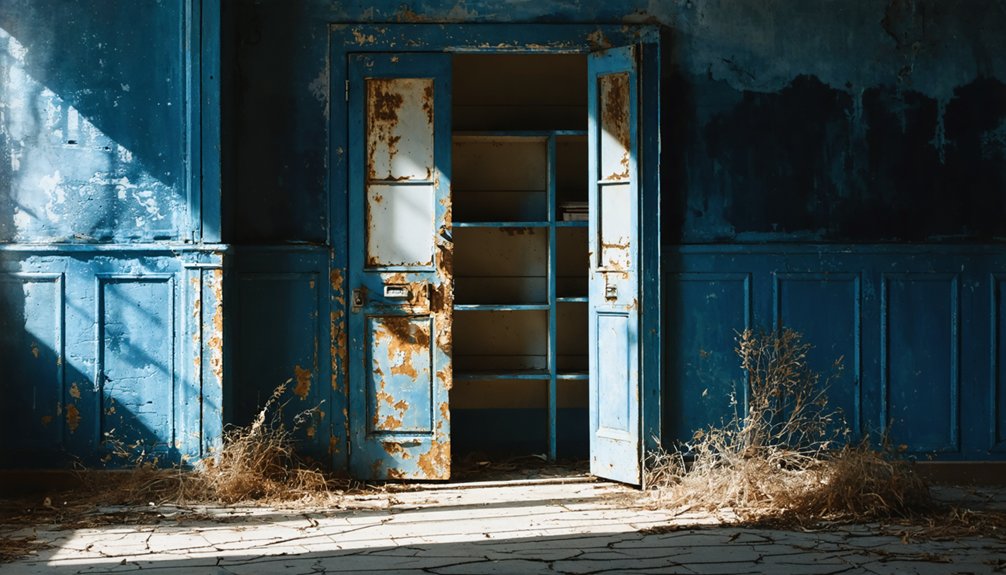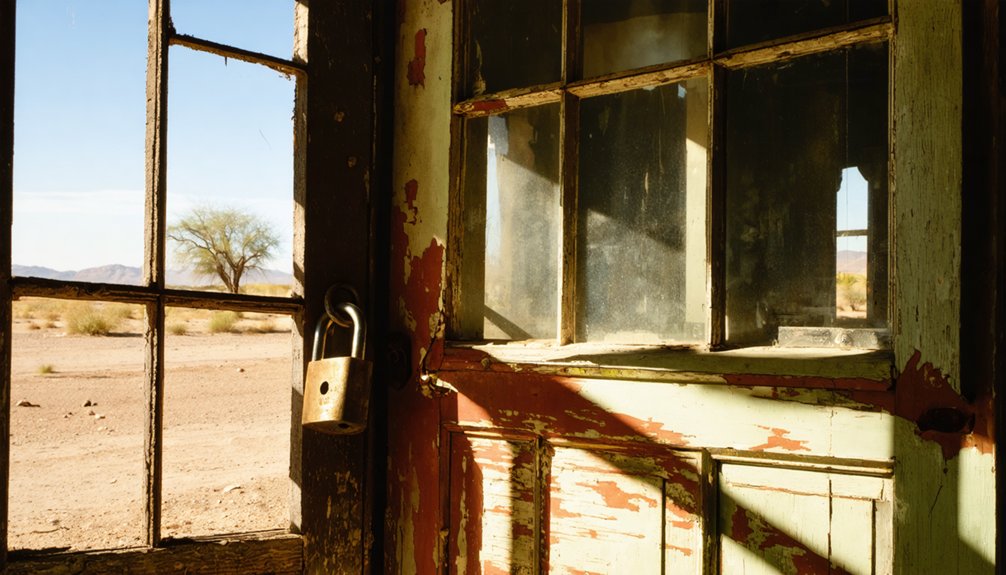Locker began in the 1870s as a bustling frontier settlement in San Saba County, Texas. You’ll find its history marked by James Monroe Locker’s arrival, which established a thriving business district with a gristmill, sawmill, and cotton gin. The town’s decline started after an 1893 fire destroyed most buildings and the railroad bypassed it. While the San Saba Mob’s violence brought Texas Rangers intervention in 1897, today’s ghost town tells a compelling story of frontier dreams and stark realities.
Key Takeaways
- Originally established in the 1870s as Knob, then Mount Pleasant, Locker became a thriving agricultural community centered around cotton and ranching.
- A devastating fire in 1893 destroyed most buildings, followed by economic decline when the railroad bypassed the town.
- The town’s business district revolved around the Locker Store, which served as both commercial hub and social center.
- Violence from the San Saba Mob and environmental challenges like water scarcity contributed to the town’s eventual abandonment.
- Locker is now among Texas’ 511 documented ghost towns, preserving its legacy through historical records and oral histories.
The Rise of a Texas Frontier Town
As settlers pushed into the Texas frontier in the 1870s, a small community initially known as Knob, then Mount Pleasant, took root in the rolling hills of San Saba County.
The arrival of James Monroe Locker and his family from Bosque County marked a turning point in the town’s development. Settlement patterns centered around agricultural practices, with dispersed homesteads spread across fertile lands suited for cotton farming and ranching. Like many towns such as Styles, the population would eventually dwindle to just four residents. Following traditions established since the early Spanish ranchers, cattle and sheep grazing became integral to the local economy.
James Monroe Locker’s arrival transformed the region, as homesteads multiplied across fertile lands perfect for farming and ranching ventures.
You’ll find that Locker’s influence grew as he established the area’s first general store and cotton gin, providing essential services to the growing community of Anglo-American farmers.
The town, later renamed in his honor, reflected the broader expansion of Texas’s frontier, where agricultural opportunities and available land drew settlers seeking independence.
Though bypassed by major railroads, the community maintained a stable population through the 1870s and 1880s.
Life During the 1890s Boom Years
During Locker’s peak years in the 1890s, you’d find a bustling business district centered around the iconic Locker Store, where Stella Till managed daily operations and locals gathered for essential supplies and social interaction.
You could witness merchants conducting trade at multiple establishments, including the gristmill, sawmill, cotton gin, and millinery shops that served the farming and ranching community. The community’s prosperity was interrupted when a devastating fire in 1893 destroyed nearly every building in town except for two structures. Like many towns of that era, Locker’s fate was sealed when the railroad bypassed it, leading to a gradual economic decline.
While specific law enforcement details aren’t documented for Locker proper, you’d see the influence of Texas Rangers in the broader region, particularly around the Regency Bridge area where they maintained order and responded to mob activity.
Daily Business Activities
Life in 1890s Locker centered around a bustling business district that served the local farming community’s daily needs.
You’d find three mercantile stores handling daily transactions in everything from household goods to farming supplies. At the cotton gin, gristmill, and sawmill, you’d see farmers processing their harvests and lumber while conducting agricultural exchanges with merchants and other farmers. Much like in Ayr and Grenada, political tensions emerged as towns competed for prominence in the region.
The town’s commercial pulse beat strongest during planting and harvest seasons, when you’d witness increased activity at the mills and stores. The surrounding area was known for its rich farmland, which supported the town’s economic growth.
Farmers and ranchers from prominent families like the Barnetts, Taylors, and Wells would trade livestock and crops, while the millinery shop offered specialized goods like hats and clothing.
The Locker Store, built of rock and run by Stella Till, would become the last vestige of this vibrant era.
Law and Social Order
While larger Texas towns maintained formal law enforcement systems, Locker operated with minimal official policing during its 1890s boom period.
You’d find community vigilance and fraternal organizations like the Woodmen of the World stepping in to maintain social order.
With no local courts or jails, judicial challenges forced residents to travel to nearby towns for legal matters, leading to informal justice systems handled by community elders.
Like many East Texas towns, Locker’s social structure was shaped by the economic opportunities brought by railroad expansion.
Similar to towns like The Grove, agricultural changes led to significant social disruption in the community.
- Economic conflicts between merchants often escalated into personal vendettas due to lack of formal dispute resolution.
- Social hierarchy depended heavily on your involvement in farming, cattle, or mercantile activities.
- Population fluctuations made maintaining order difficult, especially during rapid growth periods.
- Resource sharing relied on informal networks of cooperation among residents.
- Crime escalation was common, with shootings and disputes stemming from minimal structured policing.
The San Saba Mob’s Influence
As the 1880s dawned in San Saba County, Texas, a ruthless vigilante group known as the “San Saba Mob” or “The Assembly” seized control through violence and intimidation.
You’d find this secretive organization deeply embedded in the community’s power structure, including corrupt officials, religious leaders, and influential citizens who wielded their authority through terror and assassination.
The Mob’s influence reached every corner of San Saba, where they’d eliminate anyone they deemed a threat. The Texas Rangers intervened to restore law and order in the region after years of unchecked violence.
Their control was so complete that witnesses would commit perjury to protect them, while their victims included both White and African American residents. The group held monthly meetings at Buzzards Water Hole where they plotted their next targets and discussed assassination plans.
Over a decade, they’d orchestrate at least 43 murders, creating a climate of community fear that paralyzed opposition until the Texas Rangers finally intervened in 1897.
Texas Rangers Restore Order
Following years of unchecked violence from the San Saba Mob, the Texas Rangers finally intervened in 1897 to restore order to the troubled region.
The Rangers deployed small, mobile units to quickly respond to disturbances and criminal activity. You’ll find their methods combined both intimidation and legal authority to break up outlaw gangs while protecting settlers and ranchers from further violence.
- Rangers established camps throughout the area to maintain constant surveillance
- Mobile units conducted swift investigations and arrests of known mob members
- Law enforcement efforts focused on disrupting cattle rustling operations
- Rangers mediated conflicts between opposing factions to prevent escalation
- Their presence helped restore civilian confidence in local government authority
The Rangers’ intervention marked a turning point for Locker, though their methods sometimes sparked controversy regarding use of force.
Business and Commerce in Early Locker

During its peak in the early 1890s, Locker flourished as a small but vibrant commercial hub centered around agriculture and essential services.
You’d find the iconic Locker Store, a rock building that served as the heart of local trade, providing crucial supplies to settlers and farmers. The town supported doctors, schools, and businesses catering to the farming community’s needs.
However, economic shifts began to reshape Locker’s destiny. When the railroad bypassed the town in the early 1900s, it dealt a significant blow to commercial growth.
Limited road access further isolated the community, and as job opportunities dwindled, residents sought work elsewhere. While the fertile farmland remains productive today, Locker’s once-thriving business district has faded, leaving only traces of its commercial past.
Environmental Challenges and Geographic Impact
Today you’ll notice striking environmental challenges in Locker’s terrain, where water scarcity has dramatically reshaped the landscape that early settlers once knew.
The region’s susceptibility to Texas droughts has intensified since the 1950s, affecting both surface water availability and groundwater reserves that once sustained the community.
The changing climate patterns have transformed Locker’s geographic features, leaving visible evidence of environmental stress on the formerly productive agricultural lands.
Water Scarcity Issues
While many Texas towns faced water challenges, Locker’s location in the state’s semi-arid region made it particularly vulnerable to severe water scarcity issues. The combination of prolonged droughts, agricultural demands, and infrastructure problems created a perfect storm of water conservation challenges that ultimately contributed to the town’s decline.
- The Ogallala Aquifer’s depletion severely limited groundwater availability for farming and ranching.
- Local surface water sources dried up due to excessive well pumping, creating a devastating cycle.
- Aging infrastructure leaked precious water resources, worsening the already critical shortage.
- Agricultural impact was severe, forcing ranchers to sell livestock and farmers to abandon fields.
- Competition between agricultural and municipal water needs created unsustainable demands on limited resources.
Regional Climate Effects
Located in San Saba County‘s variable climate zone, Locker faced significant environmental challenges that shaped its ultimate fate as a ghost town.
You’ll find its history deeply intertwined with seasonal variations, from hot, humid summers to cold winters, which directly impacted agricultural sustainability. The town’s rural infrastructure, primarily 2WD roads, couldn’t shield it from intense weather patterns that stressed farming operations and community resilience.
Climate change and environmental stressors took their toll on this once-thriving farming community. The combination of population shifts, economic pressures, and agricultural impacts proved overwhelming.
Without adequate resources to combat these challenges, families gradually abandoned their generational farmlands around Barnett Mountain. The region’s weather patterns, coupled with limited access during extreme conditions, ultimately contributed to Locker’s shift from an active settlement to a ghost town.
The Turning Point of Decline

Like many small Texas settlements that failed to secure railroad connections, Locker’s decline began when major transportation routes bypassed the community in favor of neighboring towns.
The declining population and economic stagnation followed a predictable pattern you’d recognize in countless Texas ghost towns, where the absence of rail service proved fatal to local prosperity.
- Loss of stagecoach routes and postal services diminished the town’s regional importance
- Local businesses closed as residents migrated to better-connected communities
- School closures accelerated the exodus of families from the area
- Competition from railroad towns drew commerce away from Locker’s merchants
- Lack of new industry or economic diversification sealed the town’s fate
The town’s descent wasn’t marked by any dramatic disaster but rather a steady erosion of its economic foundations, leading to inevitable abandonment.
Remnants and Ruins Today
Today’s visitors to Locker will find little evidence of the once-thriving settlement, as decades of abandonment have reduced the town to nearly invisible traces on the Texas landscape.
If you’re interested in ruin exploration, you’ll discover that nature has reclaimed most of the site, with vegetation obscuring what remains of building foundations and scattered rubble.
While historical artifacts occasionally surface among the deteriorating remnants, there aren’t any standing structures left to explore.
The harsh Texas climate has accelerated the decay of what was once here, and without preservation efforts, these physical connections to the past continue to fade.
You won’t find tourist facilities or interpretive signs, but the site still draws attention from historians and photographers documenting Texas’s vanishing ghost towns.
Legacy in Texas Ghost Town History

While many Texas ghost towns emerged from mining booms or railroad speculation, Locker’s legacy stands apart as an agricultural settlement that illuminates a different aspect of the state’s frontier development.
As one of Texas’ 511 documented ghost towns, Locker’s story preserves crucial cultural heritage tied to farming communities and rural life. You’ll find its significance deeply rooted in the transformation of the American frontier.
- Long-standing family names like the Barnetts, Taylors, and Wells showcase the community’s generational commitment to agricultural development.
- The iconic Locker Store served as a social hub for nearly a century.
- Texas Rangers’ presence reflects the complex relationship between law enforcement and frontier communities.
- The town’s decline mirrors broader rural-to-urban migration patterns.
- Locker’s agricultural origins contrast with typical boom-and-bust mining town narratives.
Preserving Locker’s Story
Despite the passage of time, dedicated preservation efforts keep Locker’s story alive through multiple channels.
You’ll find the town’s heritage preserved through the Texas Ghost Town Newspaper Collection, which archives essential records of daily life and community events from before 1970. The rock Locker Store building and surrounding farmland serve as tangible reminders of the area’s commercial and agricultural past.
Community engagement remains strong through long-standing families like the Barnetts, who maintain local properties and contribute to oral histories.
Historical documentation efforts by local societies guarantee that Locker’s legacy endures through written records, photographs, and archived newspapers.
While the town’s physical presence has diminished, you can still explore standing structures and experience the historical landscape that connects modern visitors to Locker’s rich past.
Frequently Asked Questions
What Were the Specific Causes of Death for Locker’s Last Remaining Residents?
You won’t find exact causes of death for Locker’s last residents documented, though they likely faced common rural challenges: aging-related conditions, limited medical access, infectious diseases, and isolation-related health complications.
Are There Any Documented Paranormal Activities or Ghost Stories From Locker?
You won’t find documented ghost sightings or established local legends from Locker. Unlike many Texas ghost towns with rich paranormal histories, there aren’t any credible reports of supernatural activity in this area.
What Happened to the Town’s Cemetery and Where Were Residents Buried?
You’ll find limited records about the cemetery’s fate, but it still exists at coordinates 31.37670, -98.88750. Most residents were likely buried there or in nearby Mesquite and Shiloh cemeteries.
Did Any Famous Outlaws or Historical Figures Ever Visit Locker?
You won’t find documented outlaw encounters with famous desperados in Locker. While the San Saba Mob operated locally, and Texas Rangers visited to restore order, no notable historical visits are recorded.
What Was the Peak Population of Locker During Its Most Prosperous Years?
Though records show only 16 residents by 2000, you’ll find that historical data doesn’t definitively state Locker’s peak population, but its role as a small school community suggests fewer than 50 residents at its height.
References
- https://www.youtube.com/watch?v=SaUCT73CKnY
- https://www.hipcamp.com/journal/camping/texas-ghost-towns/
- https://texashighways.com/travel-news/four-texas-ghost-towns/
- https://www.ghosttowns.com/states/tx/locker.html
- https://www.lonestartreasure.com/texas-ghost-towns-and-their-buried-riches/
- https://en.wikipedia.org/wiki/List_of_ghost_towns_in_Texas
- https://mix931fm.com/texas-ghost-towns-history/
- https://www.texasescapes.com/TexasHillCountryTowns/Locker-Texas.htm
- https://www.texasescapes.com/TOWNS/Texas_ghost_towns.htm
- https://www.thestoryoftexas.com/discover/texas-history-timeline



